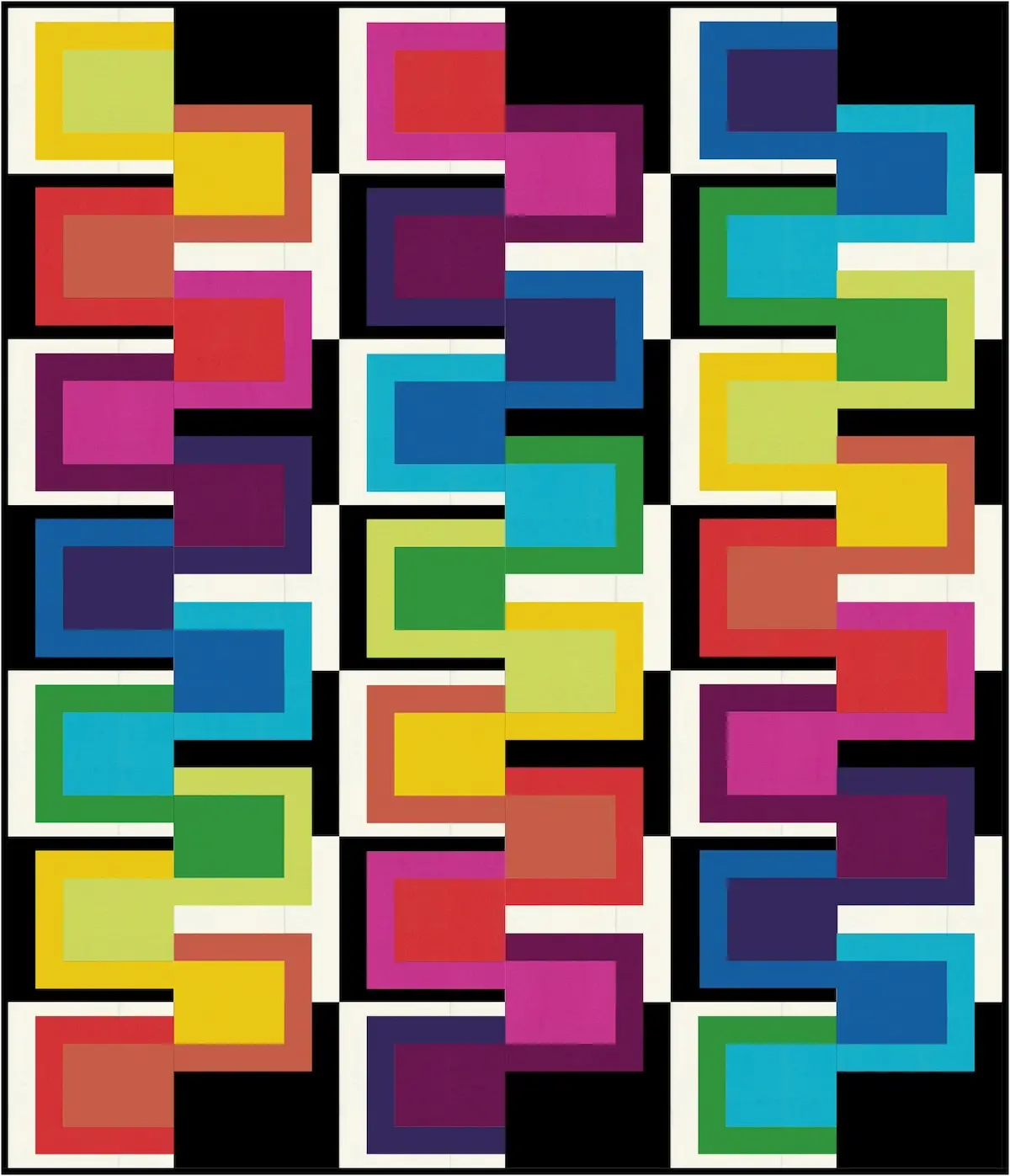Linda Sullivan’s quilting journey is full of color, joy, and a little bit of serendipity. From her early days of crafting to discovering bold, happy fabrics that reignited her passion, she’s built a vibrant career alongside her husband Carl. Together, they run Colourwerx, designing playful quilt patterns and fabrics that celebrate creativity every day.

Can you tell us a bit about your creative journey? How did you first fall in love with color, texture, and fabric?
I crafted a lot as a child – drawing, pottery, crochet, needlepoint – but I never considered myself ‘creative enough’ to actually create a piece of art, and certainly never imagined that I would end up pursuing the craft of quilting as a full time career.
Although I was involved in theater from early on and majored in college earning a BA and MFA in Theater Management, I was involved in the logistical side of the industry – scheduling, contracts, budget, hiring and firing – areas that were necessary for a successful production but never considered “creative”.
When I was working at Walt Disney Imagineering, in an effort to destress from my corporate job, I began quilting just as a hobby and that really opened up my creativity.
As an Amazon Associate I earn from qualifying purchases. Read more about our affiliate linking policy.
The simple act of stitching several pieces of fabric together to create a quilt block, repeating that process to form an overall design and stepping back to see the secondary patterns emerge between the quilt blocks was really exciting. I couldn’t wait to stitch the next set of blocks, to finish the next quilt top, or when discovering fusible web machine appliqué, to draw out a character or any shape imaginable, and use the fabrics and threads to further texturize that appliqué shape.
The designs and the mixture of colors on the printed fabrics provided that additional detail to each shape that I had only imagined but could never translate to pen and paper. The possibilities were suddenly endless.
Carl, on the other hand, was always immersed in “creativity”, having been involved in the arts in grade school, attending the Croydon School of Art in London and then working for many years as an art director/set designer in the West End of London (this is similar to Broadway in NYC), before migrating to Southern California to work as a Production Designer in television and film. He has an innate sense for combining colors and shapes seamlessly together, which serves him well in designing our quilt patterns.
What first inspired you to become a maker?
I started quilting like most people do, by taking a beginning quilt class at my local shop. At that time, Carl and I were living in Southern California and enjoying successful careers in the television and entertainment fields. He was working as an Art Director in Hollywood, and I was working as a Project Manager for Walt Disney Imagineering.
I was hooked in the first hour of class. I loved the idea that I could cut out the units for a block and have it stitched together that evening after returning home from work. And I could repeat that process several times a week or even over a weekend and have a finished project.

After that beginning quilting class, I started looking for other avenues and projects to explore. On a whim, I took myself to the Road to California Quilter’s Conference and signed up for a workshop with the great Freddy Moran. I knew nothing about her, but I just liked her look and those big, red, round eyeglasses.
My stash at that point was what was only available in our local quilt shop. It was 1999, and Thimbleberries was all the rage and Debbie Mumm was very popular. Every fabric was cast in yellows, browns, and rusts. Yuck! And although it was fun to play with the fabric, it was a very uninspiring color palette. I almost gave up quilting all together because I found the fabrics quite dull and boring.
I had no idea what I was getting into by signing up for Freddy Moran’s workshop, and walked into her class with my small stash of rather dull looking fabric and an open mind…. I remember to this day – she looked down at my fabrics and said, “Do you really like these fabrics??”…to which I shrugged, and then she said , “Well I thought so-these are dull and uninspiring, don’t you think? There are no fabrics here that are particularly colorful…These are not happy fabrics!”
After a quick lesson with the color wheel, she sent me down to her favorite vendor at lunch and asked me to pick out 12 ‘pure color’ fat quarters to work with in the remainder of class. The vendor booth was filled with saturated bright colored fabrics and lots of black and whites – (gasp!) no brown! I was in heaven! To Carl’s dismay, I spent over $500 on that lunch hour, and treated myself to a brand new stash which I was overjoyed with but more importantly, reignited my passion for quilting.
I learned a great lesson from Freddy that day that I still share with many students and customers some 25 years later – “Use the pure hue of any color and never, ever compromise, and use fabrics that make you happy!”.
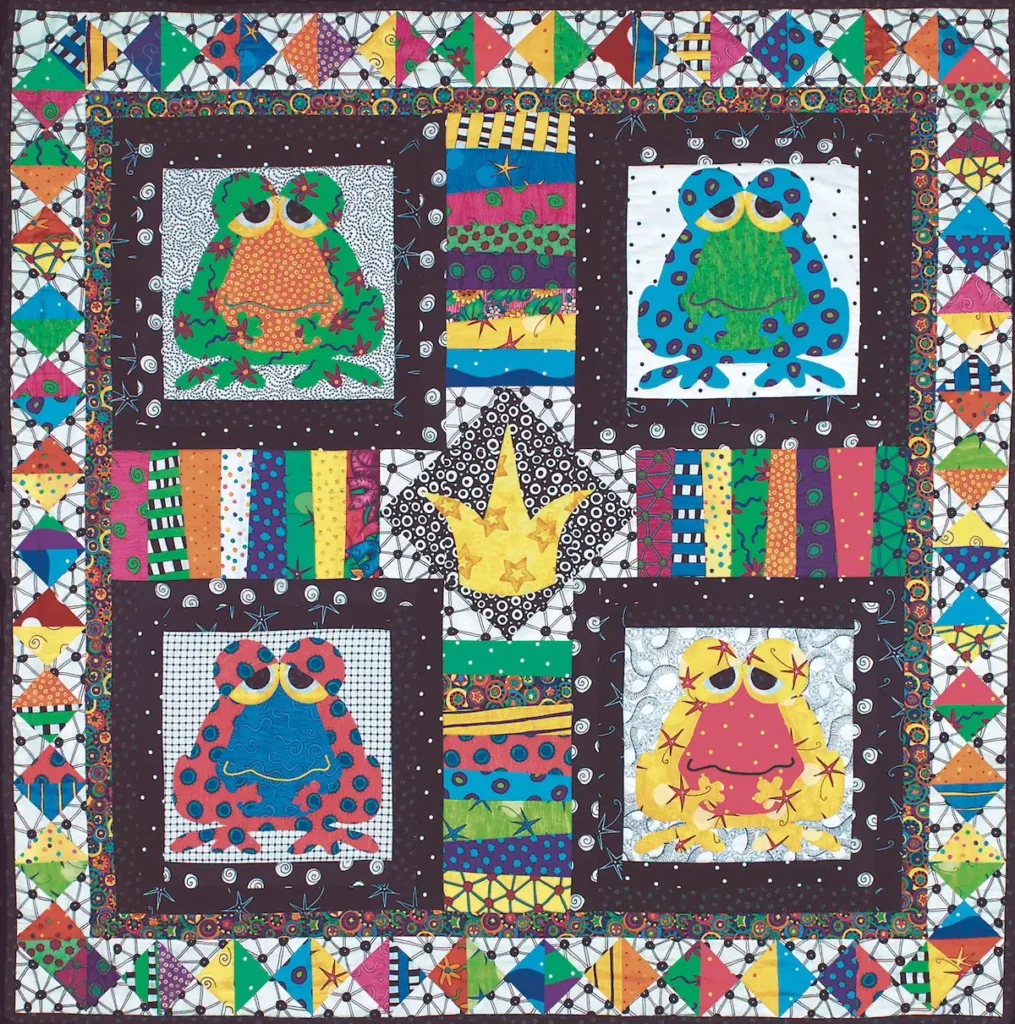
When and how did you decide to make quilting a full time career?
Shortly thereafter I took a Raw Edge Machine Appliqué class at my local quilt shop which I loved and still do to this day. Armed with my new colorful stash from Road, and my newly developed skills of machine appliqué, I set out to make a new quilt.
Not finding a pattern that really thrilled me, I went home and designed a quilt with a four, smirking toads based on a greeting card I had received. When I went back to the quilt shop to find a backing fabric, the owner asked for the pattern. When I stated that I just put it together myself she replied “I could sell a million copies of that pattern – it is so cute! You should write a pattern and come back with copies. I will purchase them from you.” I went home and thought, ‘Well…sure why not? That would bring in extra money to buy more fabric!” So I did!
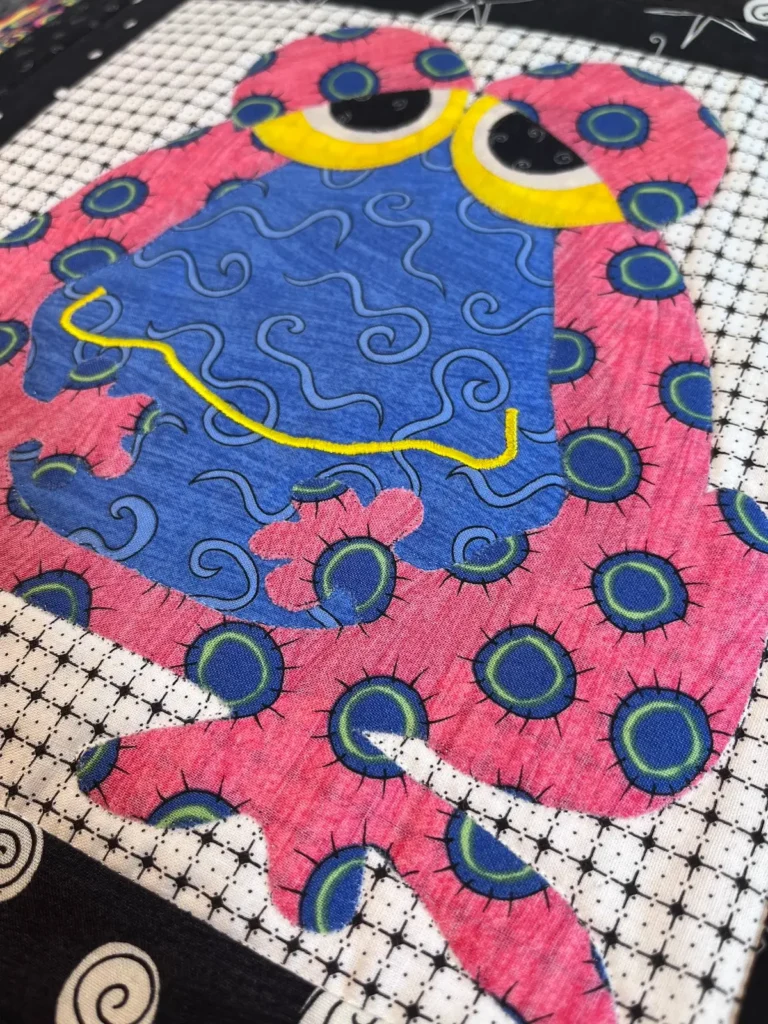
That little toad pattern launched Carl and I into our first pattern design company called, Linderella’s Quilt Design Studio. First named “My Kingdom for a Toad” and now called “ModFrog” – that pattern sold over 75,000 copies in its heyday from 2002 – 2008.
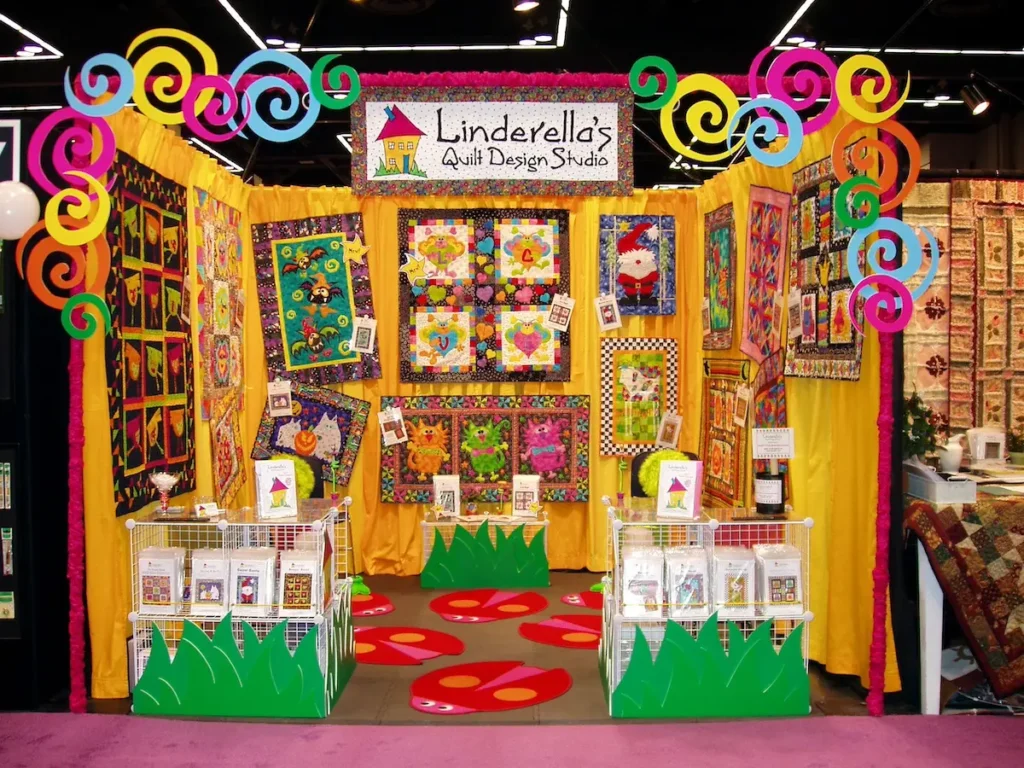
Once that first pattern was released, demand grew for more whimsical, brightly colored, appliquéd patterns, and soon Carl and I had a full time business on our hands: publishing more quilt patterns, attending quilt markets; designing for magazines; vending at local shows, and designing our first collections of fabric. All of this afforded us to leave our television and film careers and concentrate on quilting full-time.
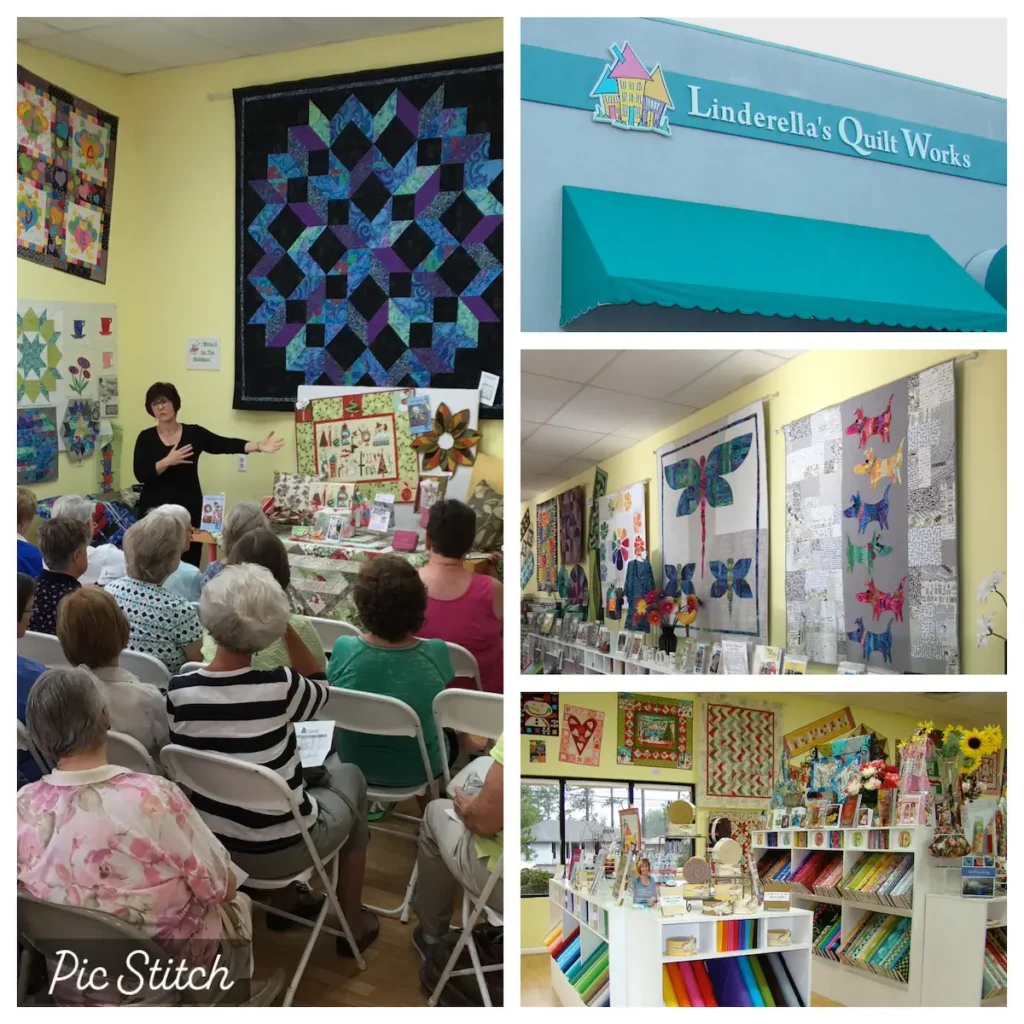
How did you end up moving to North Carolina to open a quilt shop and eventually get back to designing quilt patterns and fabrics in Colourwerx?
After 2008, we decided quite on a whim to move out of Los Angeles – which we found too crowded at the time – to a small town in North Carolina, called Pinehurst. Since there were no quilt shops within a 75 mile radius but quite a large quilting guild in the area, we decided to open our own quilt shop, called Linderella’s Quilt Works.
And why not? It would be a new experience and we felt ready for the challenge of running our own retail establishment. It was just the two of us in the shop, but we had a ball.
Needless to say, it was hard work and left no time for designing patterns or fabrics, as every waking moment went to running the shop, sewing samples, and tending to customers. We carried a large stock of Kaffe Fassett fabrics, and I remember being in awe of the designs and, more importantly, the variety of colors he used on his fabrics… So many colors on one print – it was just fabulous!
In 2015, we were approached by Free Spirit Fabrics to design and create on commission quilt patterns with a contemporary feel for Free Spirit and the Kaffe Fassett Collective. We jumped at the chance and began a fruitful relationship with Free Spirit Fabrics designing and making several quilts each quarter that appeared in the Free Spirit lookbooks, Quilt Market booths, and in their national trunk shows that travelled throughout the world.
These intense, but fun three years, reignited our passion and drive to design patterns and fabrics. After 9 years of shop life, we decided to close Linderella’s Quilt Works and return to our first love of designing patterns and fabrics. We started Colourwerx in 2016 with an emphasis on designing contemporary modern patterns and fabrics. Additionally, we really missed Southern California ,so we decided to return and move to Palm Springs, where we live now.
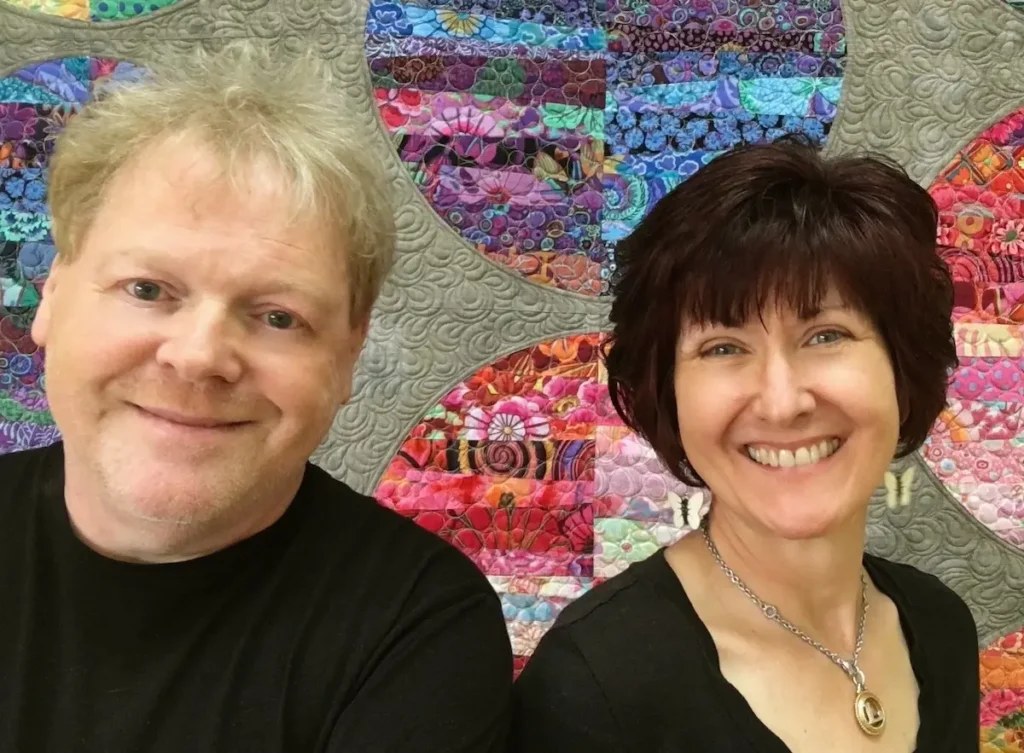
You and your husband work together in your Colourwerx business. Why is Colourwerx spelled differently with an “ou” and do you each have specific roles and responsibilities, or does the work flow back and forth between each other.
The way Colourwerx is spelled is a tribute to Carl’s British background. He will tell you that spelling the word ‘colour’ with the “ou” is the ‘only correct and proper way’ to spell the word colour, and the “werx” instead of “works” is a further tribute to his European roots. Additionally, it is also very intentional, as we needed a way to separate our brand from the other companies in the industry that were frequently using the words ‘color works’ in their company description or for fabric collections.
As for specific roles and responsibilities, I don’t believe we have ever formally sat down and divided the duties up between us. He and I simply take on the day to day tasks that we enjoy doing and because we are better at accomplishing them than the other partner.
I make most of the quilt samples, tend to the communications from clients, contracts, bookkeeping and update the website. Carl does all order fulfillment, printing, shipping, engages retail customers, and many times also stitches sample quilts or assists me in the sewing studio.
How do you move from an idea to a fully realized design?
Although we may first brainstorm general concepts for a new pattern or fabric collection and agree on a general direction/timeline, we then retreat to our separate spaces to work on the new patterns or fabric designs. This is intentional as we have two totally different ways of designing.
Carl designs the majority of our precision pieced or foundation pieced patterns and has a much more bold, graphic style. He often uses simple geometric shapes in new configurations or transforms them into new shapes or designs. He designs the majority of his patterns and surface designs in Adobe Illustrator. We often refer to Carl’s quilt patterns as “looks complicated but it’s not”.
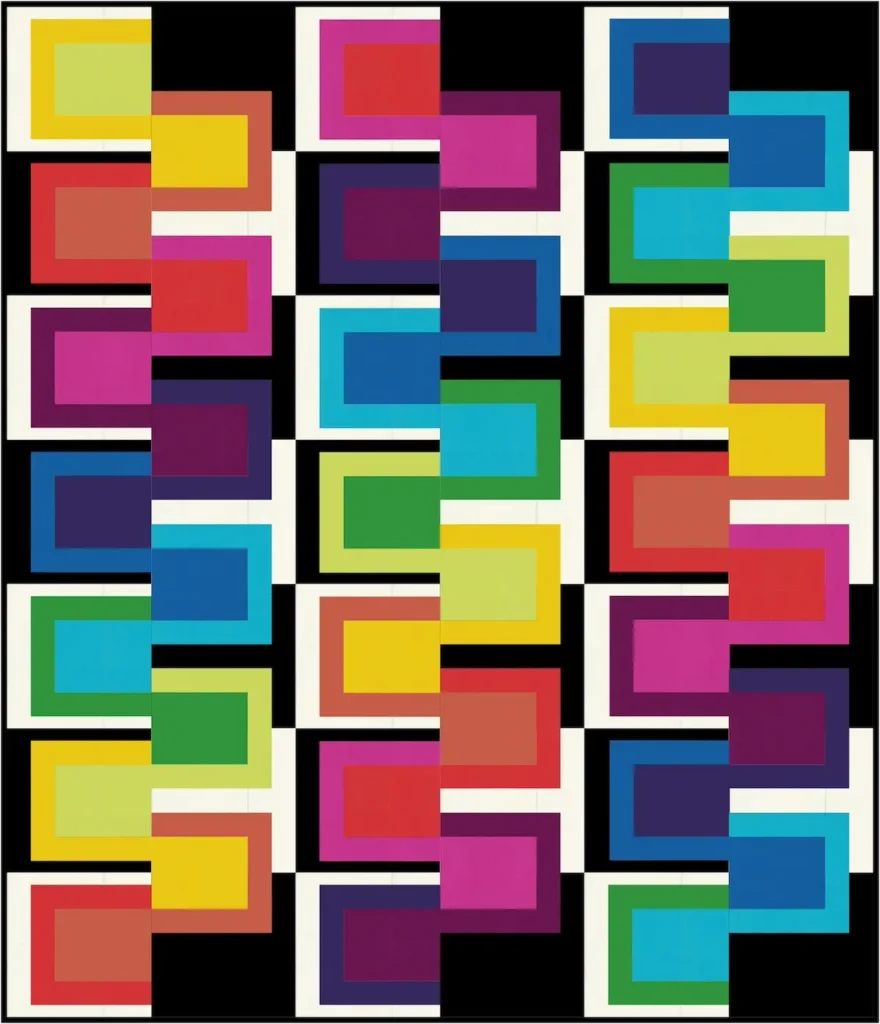
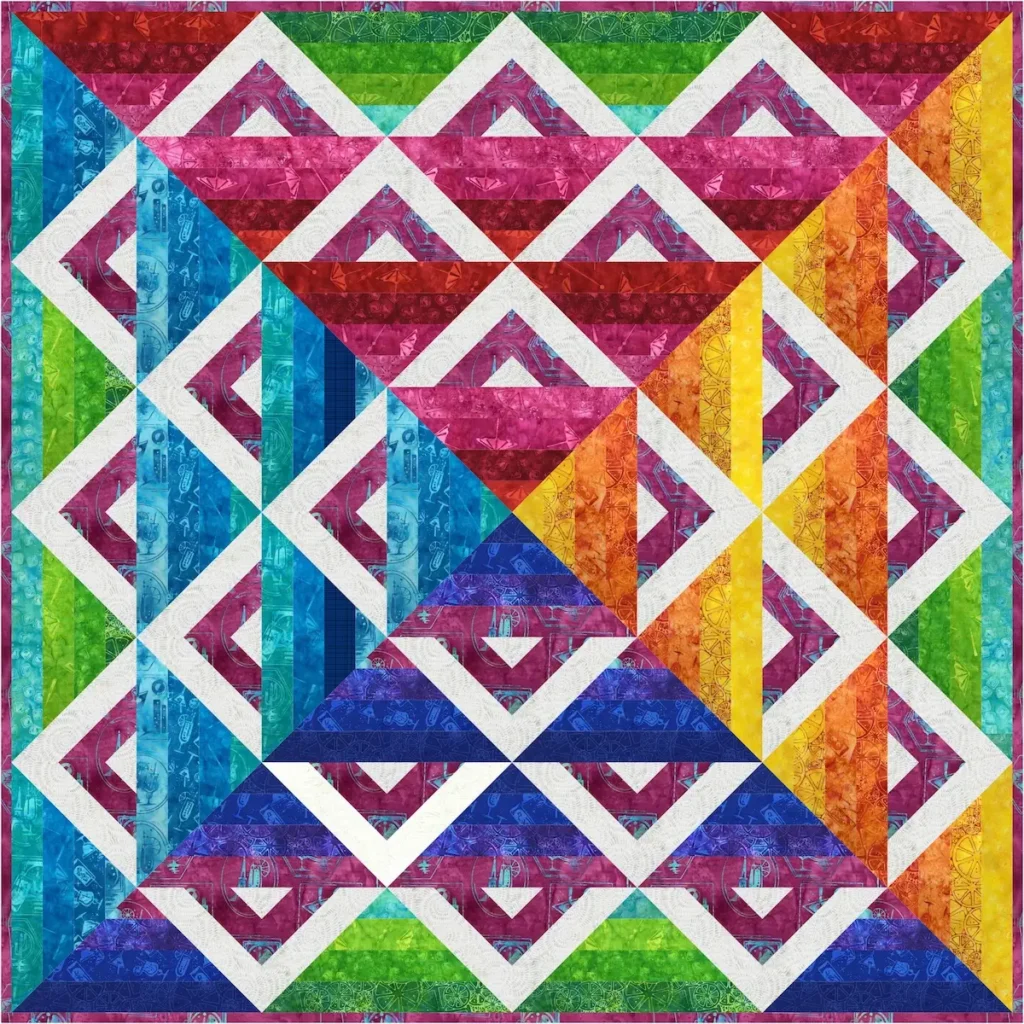
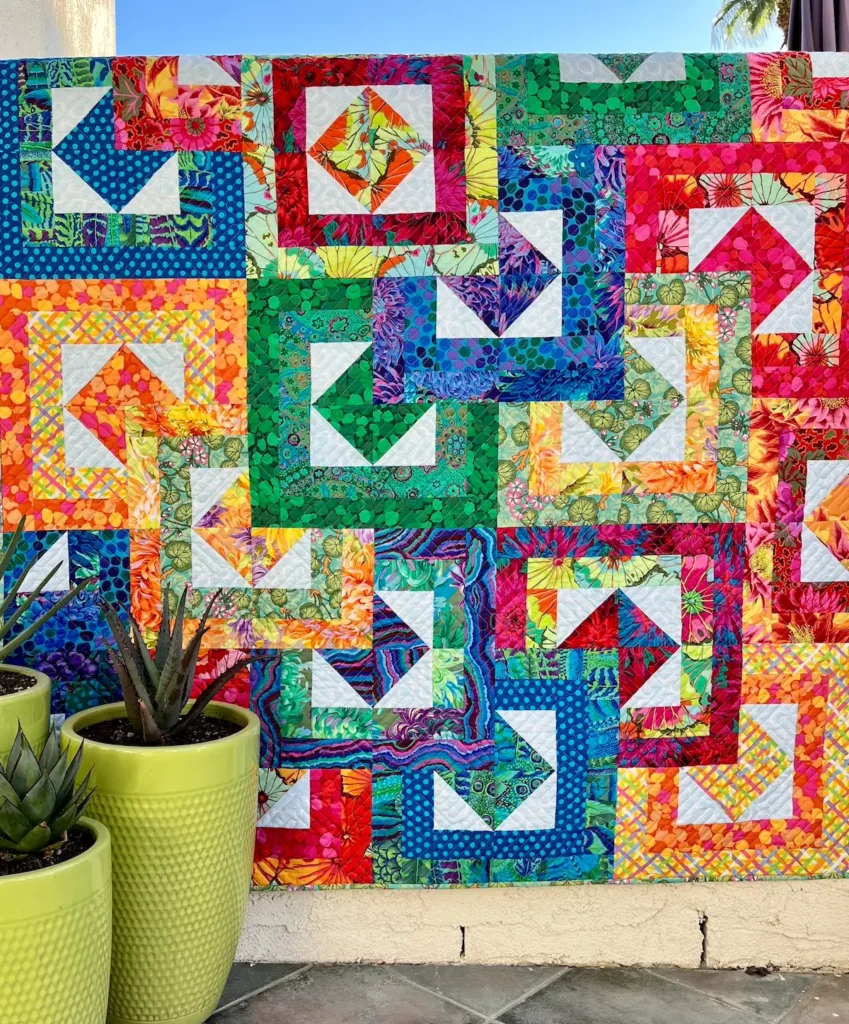
I design more organically and create most of our appliqué patterns and the more liberated pieced, slash ’n sew patterns. At first, I might scribble a design with pencil and paper to flush out an appliqué shape or stitch a few test blocks together for an idea that has been percolating. After that, I will work out the design on paper or in Illustrator.
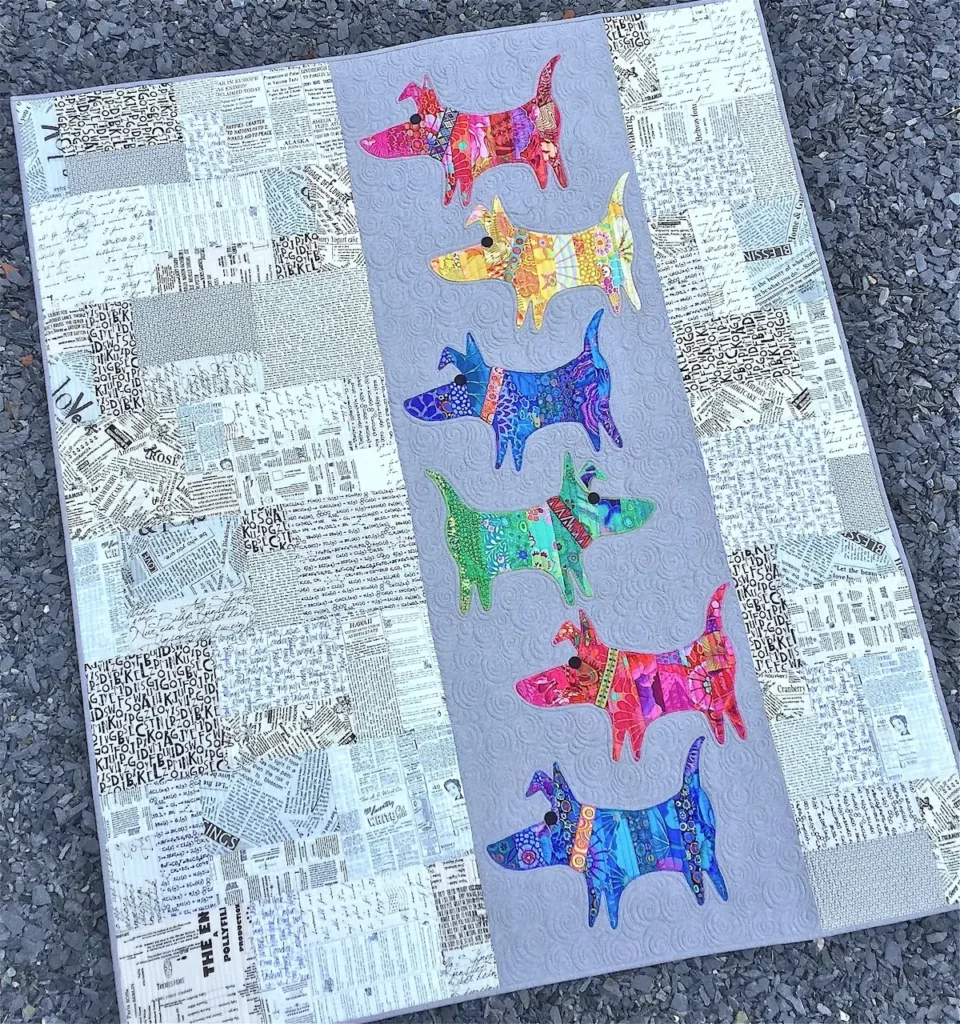
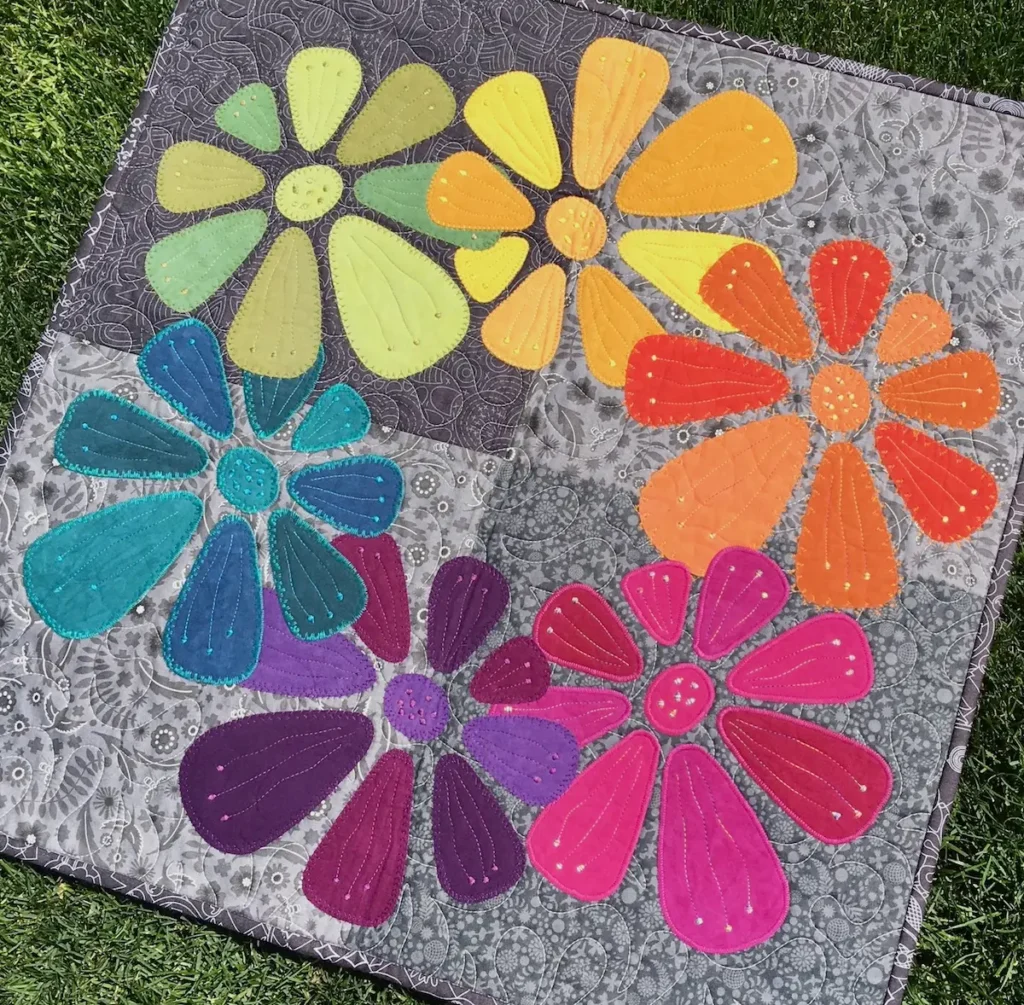
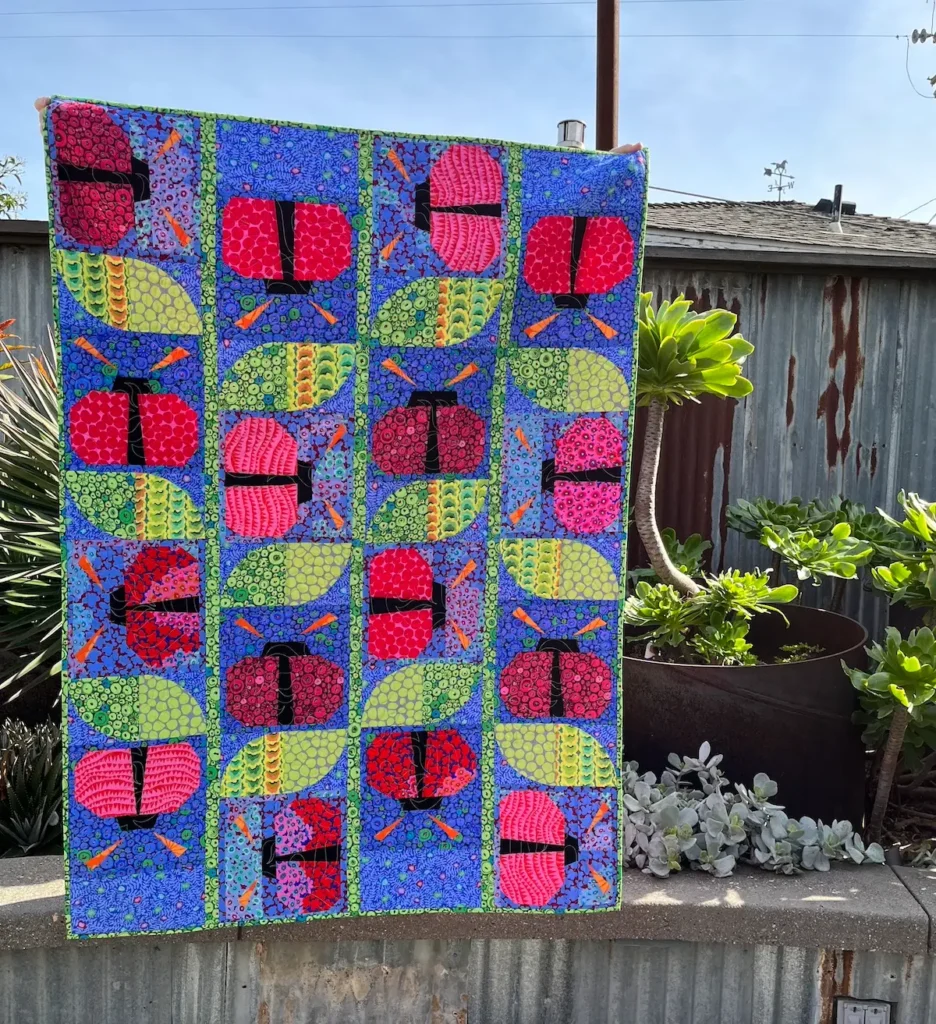
To finalize, the design for a new pattern or the skus on a new fabric collection, we present our ideas to each other and ultimately agree on the final look.
Where do you find inspiration for your patterns and surface designs?
Anywhere and everywhere literally! Of course we live in a very colorful city and love it! Palm Springs is the mecca of mid century modern architecture and old Hollywood, as well as being one of the fastest growing vibrant communities in California that celebrates all lifestyles.
Color, art, wonderfully shaped buildings, architecture and colorful people are on every street corner and provide constant inspiration for new designs. Much of the city’s artwork on the streets or in parks provide fantastic backdrops when we photograph our quilts!
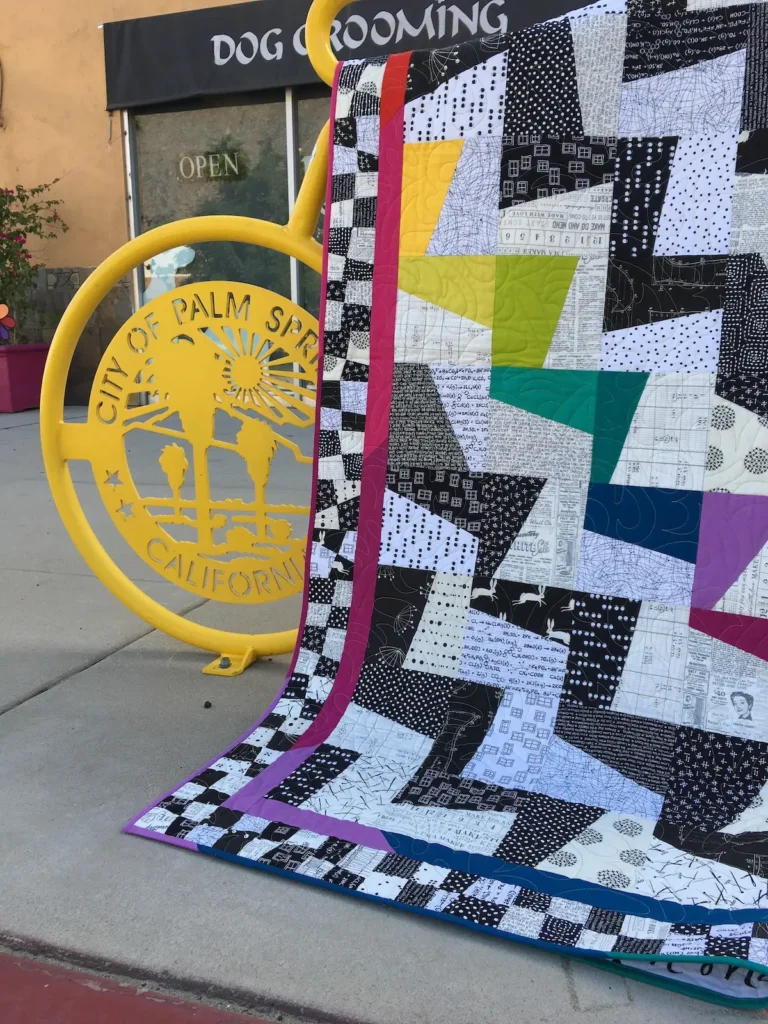

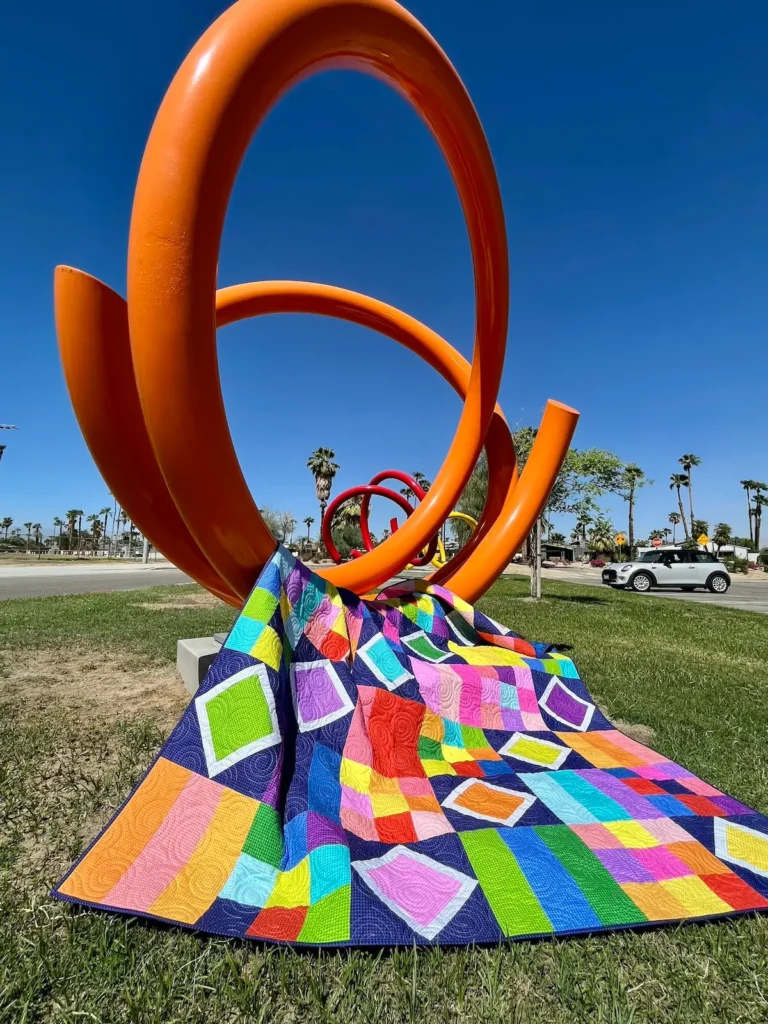
However inspiration can be also as simple as seeing an everyday object in a new way…For our ColourMaze pattern, Carl found a staple on the office floor and used that as the inspiration for the block.
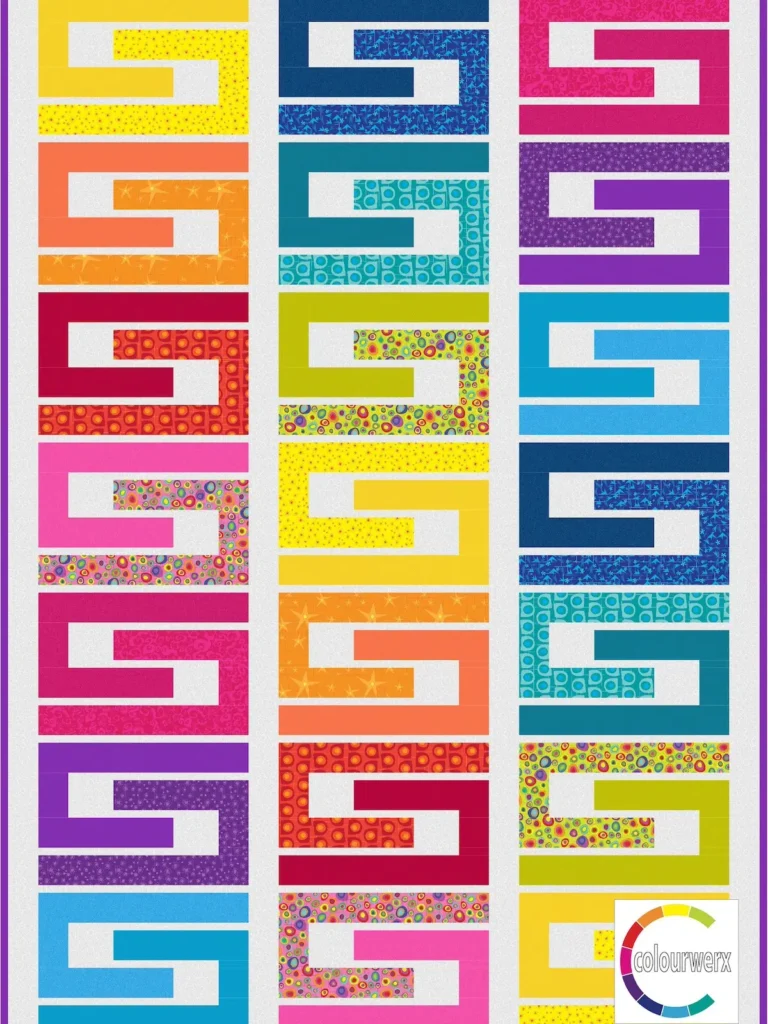
How do your daily activities influence new designs?
Because our business is our daily activity, it constantly influences and generates new designs for patterns and fabrics.
We purposefully plan out the launch of new patterns with new fabric lines, or the addition of a new workshop with new products. Every week in the business generates something new to design, or produce, or plan for, and that in turn, becomes activities for the day.
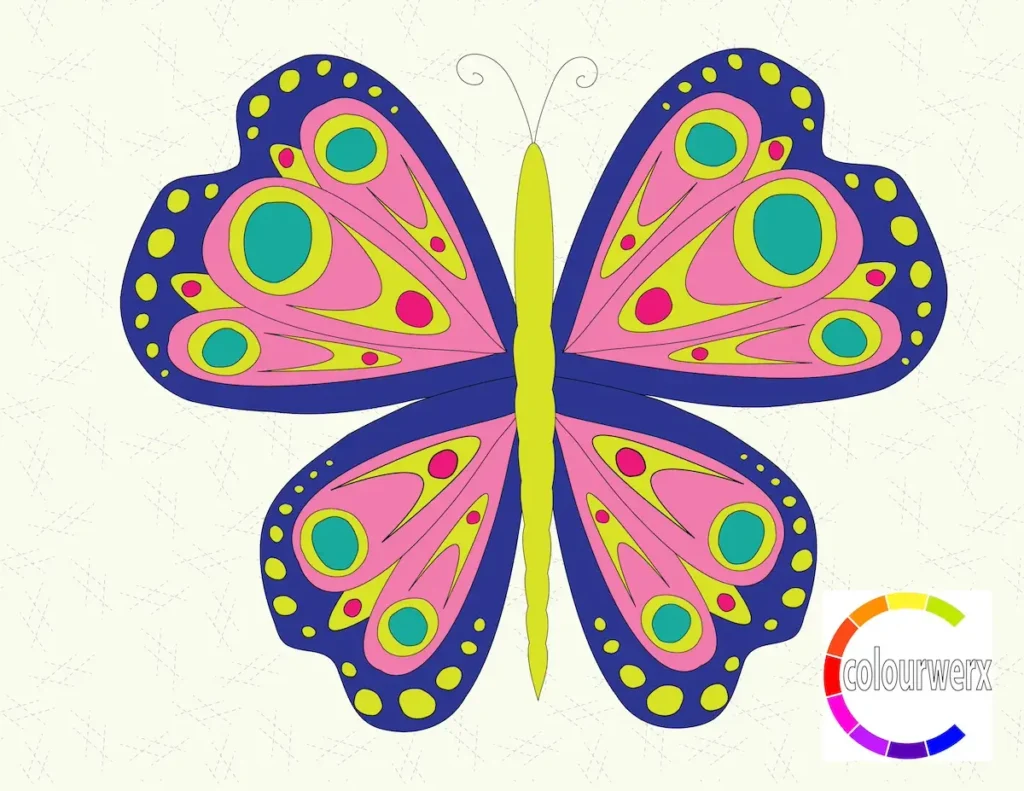
For example our newest fabric collection from Benartex Fabrics called “Kaleidoscope” is full of brightly colored butterflies and other coordinate designs that evoke the very colorful transformation butterflies go through when emerging from their pods.
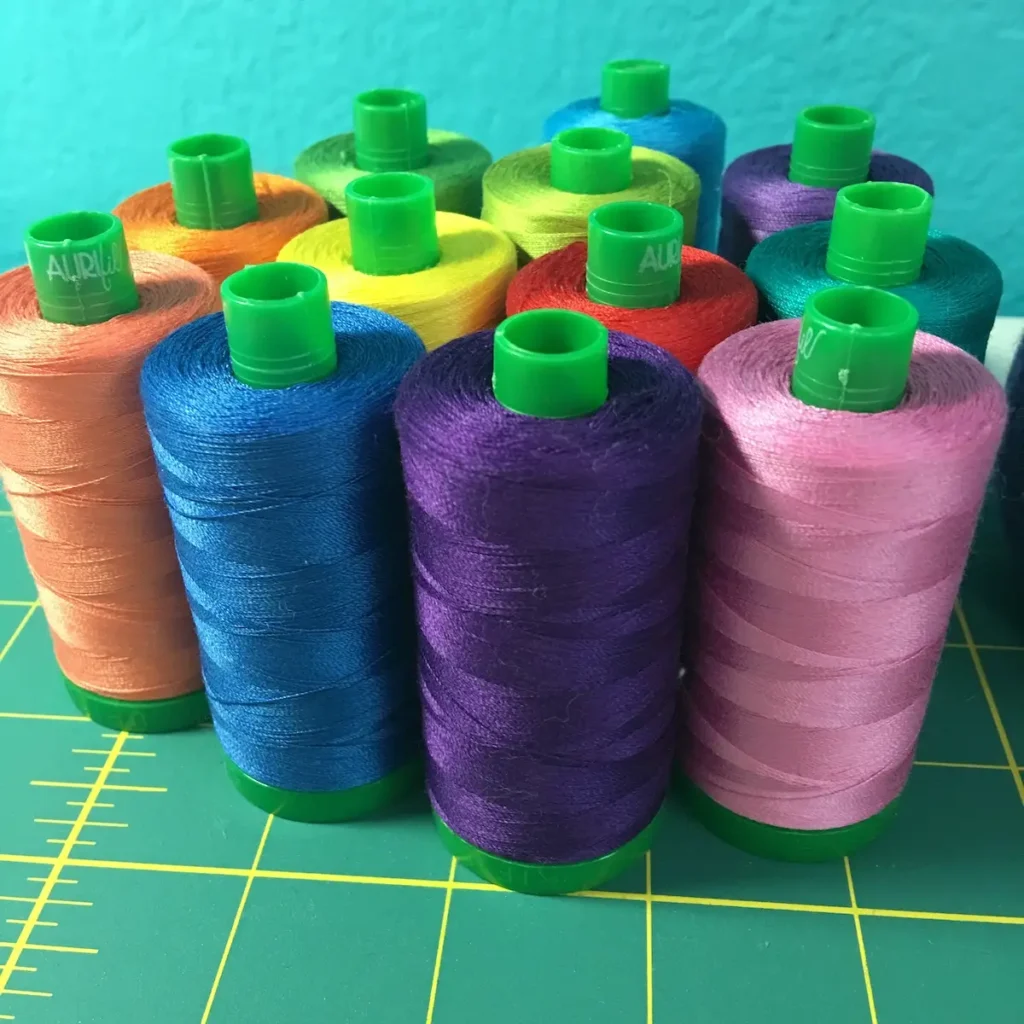
Accompanying products to the new fabric collection will include new quilt patterns, but also butterfly greeting cards, butterfly stickers, a thread collection with Aurifil, and even a mystery block of the month quiltalong that are now all in the design stages, well before the fabric arrives in shops in April/May 2026.

Your color palette is joyful and harmonious. What guides your choices of hues?
We always prefer the pure, unaltered hue of any color – meaning it is neither a tint nor a shade but is the ‘pure color’ of that hue.
Color wheel order is the most harmonious and joyful of color palettes and one can start anywhere on the color wheel to achieve the effect. We use color wheel order quite often throughout many of our quilt patterns.

What advice would you give someone who wants to build confidence in their color sense and composition?
Don’t discriminate against any color – by doing so, you may be missing an opportunity!
Also challenge yourself use new color palettes in your next quilting project. One way is to simply grab the color wheel and use one of the universally accepted color schemes explained right on the color wheel or at the beginning of any color theory book.
Color schemes like: analogous, complementary or monochromatic. Use the color wheel to help you decide on the hues in your color scheme, and if additional choices are needed, expand that color palette by adding the light, medium, or dark values of each of those hues chosen.
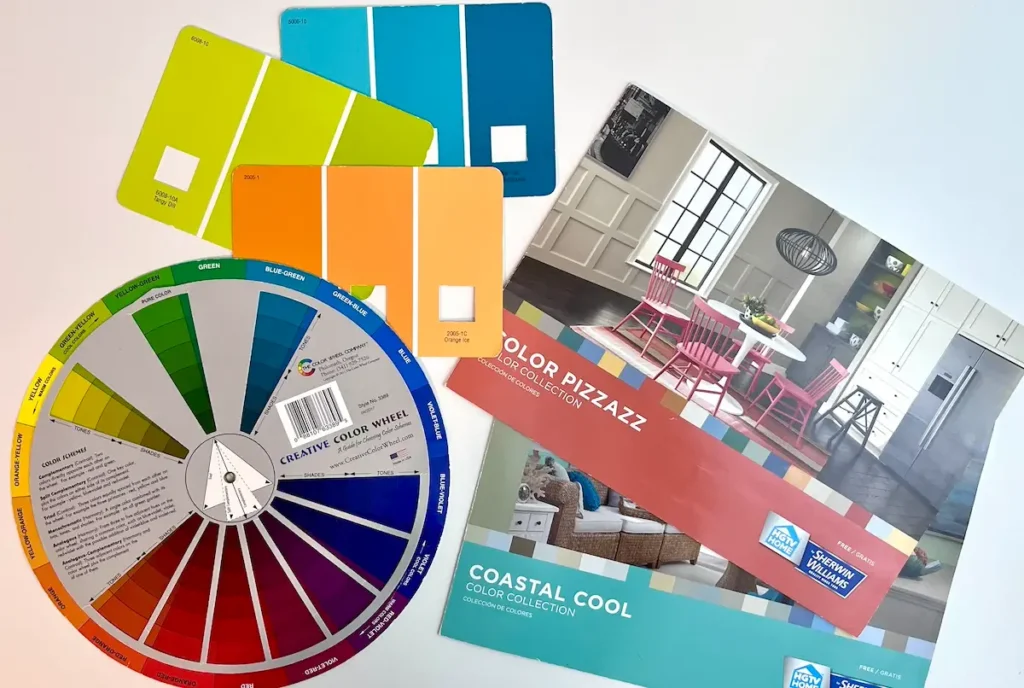
Another way is Carl’s favorite design tool – use paint chips. Paint chips are wonderful ways to expand color sense and also push you out of your comfort zone.
The paint chip look books that are available at all paint stores or at the Home Depot are wonderful tools to inspire a new color palette and help build confidence.
And what could be better? The paint companies have spent thousands of dollars hiring interior design directors and stylists to put together the most trendy color combinations. The colors (or paint chips) are all there and and the look books are free to you!
Take the chips to the quilt store, select your hues, even expand on those hues by again selecting light, medium, and dark values of those selected colors, and you’re ready to start your next project!
What strategies do you use to work through creative challenges?
Everyone experiences dry spells or creative ruts from time to time. It’s part of the creative process.
I have found it’s best not to force creativity. If you’re not feeling it, well you’re not feeling it….do something different on that day…garden, clean the house, go shopping, or just take a long walk.
Sometimes performing the most mundane tasks for a day or two or three gives your creativity time to rest, reset, and most importantly, recharge!
I also like to practice the ‘One Hour Rule’ in the mornings. I wake up, read the headlines, enjoy a few cups of coffee, and putter around the house before jumping right into the studio.
New ideas are generated from these quiet moments, and I find that puttering at times can increase my productivity for the rest of the day.
How do you balance spontaneity and rigor, letting creativity lead versus planning ahead?
Unless we have hard deadlines to meet, spontaneity (or play) always triumphs. Some of the best ideas and designs have been generated by allowing ourselves just 15 minutes of play’ a day.
How do you balance running a studio, creating and managing everyday life?
It’s all wrapped into one.
I worked for several years in the 9-5 corporate world at Disney and ultimately decided to leave when our first pattern company took off, but also because of boredom.
At that time, Carl and I made the very conscious decision to live a ‘creative life’.
It can at times be undisciplined, messy, chaotic, demanding, downright scary and terribly unforgiving. Yet, the rewards of owning your own business, setting your own schedule, creating for a living, and loving what you do for a living, far outweigh the negatives.
Every day, there is always something to look forward to and something new to create!
Describe your creative space.
Our studios are actually quite modest – nothing really to boast about for sure! We have been fortunate to have small and large sewing studios over the years, and of course, an entire quilt shop to use as our creative space as well.
Both of us now work in separate converted bedrooms in our Palm Springs home.
Carl has his space with desk, computers, and printers, and I have my separate space with desk, computer, sewing machines, and cutting areas. The closets in each bedroom have heavy-duty wardrobe racks that store all of our quilt samples for lectures and workshops. When we are teaching via Zoom, streaming live with our monthly Fab Friday broadcast, or taping a new tutorial, my studio is converted into the “video studio” with lighting, cameras, and quilt stands to hang samples.
These days I really enjoy the smaller studio space as it encourages me to keep it tidy and not to ‘hoard’ too many unfinished projects, fabrics that may never see the light of day or unneeded notions.
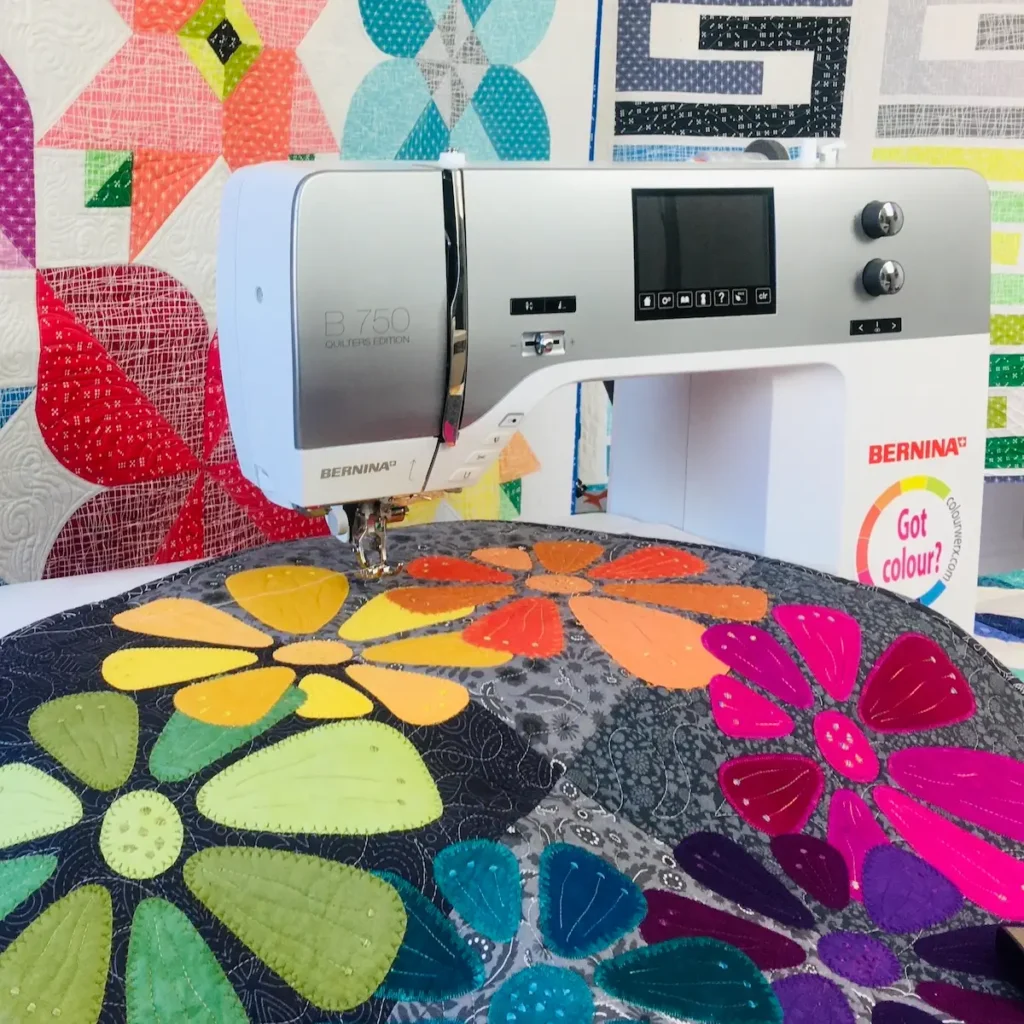
What are your “must-have’ tools and materials?
My BERNINA 750 QE sewing machine is my prized possession. It’s just a work horse of a machine, has hundreds of decorative stitches for machine appliqué and has been my steady and reliable partner for these last 12 years. (Well…besides Carl that is….)
In addition to my BERNINA, and of course other basic quilting tools, my collection of 40 weight Aurifil thread is a must! I love it for machine appliqué stitching and free motion machine quilting. The weight is perfect as it defines the edge of of the appliqué shape better than a 50 weight and also provides wonderful texture to an appliqué shape when using the decorative stitches.
This year I was thrilled to be invited to join the Aurifil Education Team as and Aurifilosopher and Certified Educator. Simply put, I will now be able to share my best tips and tricks for working with beautiful Aurifil Thread in a new lecture and on the AuriBuzz Blog!

Are there materials or tools you’ve discovered recently that opened up fresh creative directions?
Adobe Illustrator – not discovered recently as we have been using it for years when designing patterns and fabrics. But the program is always evolving and changing, especially now with the advent of AI, which as a designer, certainly opens up new ways for creating.
What’s one tip you wish you’d known when you first started quilting?
Always stitch a scant 1/4” seam…meaning a thread less than a full 1/4” seam.
It makes all the difference in the world because the thread, the layers of fabric being pressed to one side, and the general nature of quilting all take up space in that precious seam allowance. By stitching with a scant 1/4” seam, you are allowing for all those extras in the seam.
Scraps. Saver or toss ‘em?
Definitely now a tosser! (Or should I say, I now donate them to my local guild).
Years and years ago, I would save every scrap. I collected an enormous, gigantic pile of scraps. And although I felt uninspired and creatively oppressed by my humongous pile of scraps, I also felt compelled not to waste these little bits I had saved.
One morning, I decided to use the scraps. I sorted for hours and hours through the piles and piles of scraps, finally deciding on a few choice chunks to make a simplex star block. I made the block and hated it. I tried one more scrap block and again was not satisfied.
I stood back and looked down at the utter mess and chaos in my sewing studio and said “enough!”. It was at that point that I decided to forever liberate myself from my enormous pile of scraps. I bagged them all into (3) 45-gallon garbage bags and donated them to the local Girl Scouts and H&H club. I came back to my studio and felt that a weight had been lifted off my shoulders. I then went fabric shopping!
And how has your creative spark evolved over all of this time?
We like to think that our “spark” is always ever evolving.
We have been so fortunate to have been involved and experienced almost every aspect of the quilting industry during our careers: from having two design businesses, to owning and operating a quilt shop; to designing fabric collections; to teaching nationally as professional educators; o having designs published in national and international publications; and to designing and creating commissioned work for major fabric companies.
Each of these experiences have taught us so much as well as opened more opportunities and inspired us to experiment, design, and create with new formats and in new ways.

Where can people see your work?
WEBSITE: All of our patterns and fabrics can be purchased at www.colourwerx.com
TEACHING: Workshop and Lecture Information can be found here: https://colourwerx.com/pages/workshops
SOCIAL MEDIA: Social media handles on Facebook and Instagram – @colourwerx.
YOU TUBE: video tutorials and replays of our popular Fab Friday broadcast can be found on the Colourwerx You Tube Channel here: https://www.youtube.com/c/colourwerx
ONLINE WORKSHOPS: I have 2 online demand workshops with Creative Spark/C&T Publishing: “Wonky Piecing & Easy Appliqué Mini Mod Dog”, and “Slash ’n Sew Mod TV.” More information about these workshops can be found here: https://colourwerx.com/pages/online-demand-workshops or at the Creative Spark website here: https://ctpub.com/pages/author-bio/linda-sullivan
AURIFIL THREADS: Aurifil Thread Aurifilosophy Lectures Information can be found here: https://www.aurifil.com/aurifilosophy
BENARTEX FABRIC DESIGNERS: Our newest fabric collection, “Kaleidoscope” from Benartex Fabrics will be arriving to quilt shops in April/May 2026 and can be found here: https://benartex.com/
Interview posted August 2025
Browse through more inspiring quilts and interviews on Create Whimsy.

